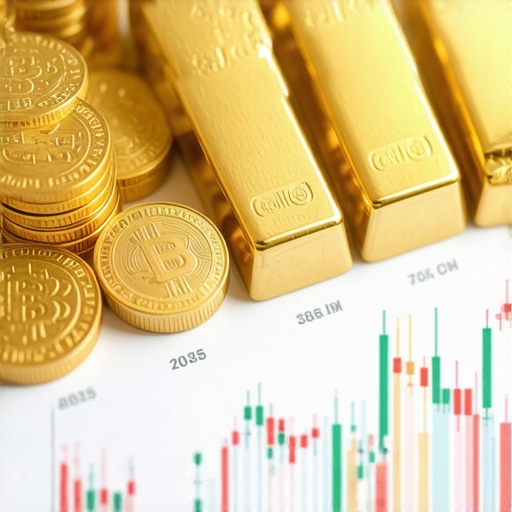Unveiling the Future of Gold Investments: Strategic Perspectives for 2025
As we approach the mid-2020s, savvy investors recognize that gold remains a cornerstone of diversified portfolios amid geopolitical uncertainties, inflationary pressures, and fluctuating monetary policies. The nuanced landscape of gold investments in 2025 demands an expert-level understanding of emerging trends and sophisticated strategies that leverage the unique attributes of coins, ETFs, and mining stocks. This article synthesizes deep market insights, emphasizing the importance of a multi-faceted approach rooted in quantitative analysis and macroeconomic foresight.
Deciphering the Evolution of Physical Gold: Coins and Bullion in a Digital Age
While digital assets dominate headlines, physical gold—particularly coins and bars—continues to symbolize tangible wealth preservation. The strategic acquisition of coins like the American Gold Eagle or the Canadian Maple Leaf, known for their liquidity and premium over spot price, remains a proven hedge against systemic risk. According to recent academic research, physical gold’s role as a safe haven is reinforced during market turbulence, yet it requires careful consideration of storage, authenticity, and premiums over the spot price.
Exchange-Traded Funds: A Liquid Gateway to Gold Exposure
In 2025, gold ETFs have evolved into sophisticated instruments offering diversified exposure with reduced logistical burdens. The key advantage lies in their transparency, liquidity, and cost-efficiency. Notably, funds like SPDR Gold Shares (GLD) and iShares Gold Trust (IAU) are backed by physical reserves, aligning with investor trust and regulatory scrutiny. The strategic deployment of gold ETFs allows investors to execute tactical asset allocation, hedge against inflation, and capitalize on short-term fluctuations, as detailed in our comprehensive ETF guide.
Mining Stocks: Harnessing Operational Leverage in a Commodity Cycle
For those seeking growth and profitability, gold mining stocks offer an indirect yet potent exposure to gold prices. Companies with robust reserves, disciplined capital expenditure, and advanced technological capabilities—such as Newmont or Barrick Gold—are positioned to outperform in 2025’s volatile environment. Analyzing their operational leverage, geopolitical risk, and ESG commitments provides an edge. As articulated by industry experts in industry reports, mining stocks can serve as a levered play on gold’s upward trajectory, especially when macroeconomic policies favor precious metal demand.
How Should Investors Balance These Strategies in 2025?
Balancing physical gold, ETFs, and mining stocks in a cohesive portfolio requires a nuanced understanding of correlation dynamics, market timing, and risk appetite. An expert portfolio considers the long-term store of value offered by physical gold, the tactical agility of ETFs, and the growth potential of mining equities. Integrating these elements with macroeconomic forecasts—such as inflation trends and central bank policies—maximizes the risk-adjusted return profile, as discussed in strategic investment frameworks.
What are the emerging risks and opportunities in gold investments for 2025?
Investors must remain vigilant to geopolitical shifts, technological disruptions, and regulatory developments that could impact gold prices and accessibility. The ongoing expansion of central bank gold reserves, as analyzed in central bank activities, presents both opportunities for price appreciation and risks of market saturation. A sophisticated understanding of these factors is essential for crafting resilient gold strategies.
For further insights, explore our detailed analyses on market trends and strategic recommendations, and consider contributing your professional perspective to enrich collective knowledge in this evolving landscape.
Reevaluating Gold’s Role in a Complex Economic Landscape
As economic indicators become increasingly unpredictable, investors are questioning whether traditional gold investment strategies remain effective in 2025. The evolving geopolitical climate, combined with technological disruptions and shifting monetary policies, necessitates a nuanced understanding of gold’s role as a safe haven and growth asset. According to our expert analysis, a diversified approach—balancing physical gold, ETFs, and mining stocks—can optimize resilience and growth potential in this volatile environment.
Advanced Tools for Strategic Allocation
In 2025, leveraging quantitative tools like Monte Carlo simulations and scenario analysis becomes crucial for crafting robust portfolios. These methodologies help investors evaluate potential outcomes based on various macroeconomic assumptions, such as inflation rates, interest rate trajectories, and geopolitical risks. For example, scenario analysis enables investors to understand how a sudden shift in central bank policies might impact gold prices, guiding more informed allocation decisions. Integrating these sophisticated tools enhances decision-making, ensuring portfolios are resilient against unforeseen shocks.
Challenging Common Assumptions: Is Gold Still a Safe Haven?
Many assume that gold’s safe-haven status is unassailable; however, recent market cycles suggest that its role may be more contextual. During periods of extreme monetary easing or technological innovation in gold extraction, prices may behave unpredictably. Industry experts, as discussed in market analyses, highlight that understanding these dynamics is essential for effective risk management. Investors should therefore consider not just gold’s historical performance but also the structural factors influencing its supply and demand in 2025.
What emerging macroeconomic and geopolitical factors could redefine gold’s value proposition in 2025?
This question pushes investors to think proactively about potential shifts—such as new trade alliances, technological breakthroughs in mining, or unexpected policy moves—that could alter gold’s valuation landscape. Staying ahead of these trends requires continuous monitoring of global economic indicators and geopolitical developments, as well as a willingness to adapt strategies accordingly.
For those seeking a comprehensive understanding of the current market dynamics, exploring our detailed guides on gold demand trends and price forecasts can provide valuable insights. Sharing your perspectives or questions in the comments can foster a richer dialogue on navigating gold investments in this complex era.
Leveraging Quantitative Models for Superior Gold Portfolio Management
In the rapidly evolving landscape of gold investments, sophisticated quantitative models such as Monte Carlo simulations, Bayesian networks, and stress testing are instrumental in designing resilient portfolios. These tools facilitate a nuanced understanding of potential market outcomes by incorporating macroeconomic variables like inflation, interest rates, and geopolitical risks. For instance, Monte Carlo simulations can generate thousands of simulated paths for gold prices, enabling investors to estimate the probability distribution of future returns and identify optimal asset allocations under various scenarios.
Furthermore, scenario analysis allows investors to evaluate the impact of specific macroeconomic shocks—such as a sudden spike in inflation or a geopolitical crisis—on their holdings. By integrating these predictive models into their decision-making processes, investors can dynamically adjust their positions, balancing risk and reward more effectively than traditional static models.
The Nuanced Role of Gold in a Diversified Macro-Hedging Strategy
While gold has historically been viewed as a safe haven, its role in a diversified macro-hedging strategy is increasingly complex. Contemporary research emphasizes the importance of understanding gold’s correlation dynamics with other assets, especially during periods of monetary easing or tightening. For example, during quantitative easing phases, gold’s correlation with equities may weaken, reducing its effectiveness as a hedge. Conversely, during inflationary surges, gold’s negative correlation with fiat currencies enhances its value proposition.
Investors should consider integrating gold into multi-asset hedging frameworks that include currencies, commodities, and fixed income instruments. This multi-pronged approach mitigates the risks associated with over-reliance on a single asset class and optimizes hedge effectiveness across various economic regimes.
Addressing the Nuanced Question: Can Gold Serve as an Inflation-Adjusted Growth Asset?
Is it feasible to reframe gold from a mere store of value to an inflation-adjusted growth asset in 2025?
This question challenges traditional perceptions and demands a multi-dimensional analysis. Recent empirical studies, such as those published in the Journal of Economic Perspectives (2022), suggest that gold’s long-term real returns are often limited by its non-yielding nature. However, in periods characterized by high inflation and monetary expansion, gold’s price dynamics can reflect real economic growth through increased demand as a safe haven and a speculative asset.
To capitalize on this, investors should consider dynamic allocation strategies that increase exposure to gold during inflationary shocks while maintaining a core position for wealth preservation. Additionally, integrating gold-related derivatives and options can facilitate tactical plays, enhancing returns during periods of rapid price appreciation.
For a deeper dive into this nuanced approach, explore authoritative sources such as the World Gold Council’s recent reports on gold’s role in inflation hedging and macroeconomic stability.
Emerging Risks and Strategic Opportunities in 2025
As we venture further into 2025, geopolitical developments—such as new trade alliances, technological breakthroughs in gold mining, and regulatory reforms—present both risks and opportunities. For example, advancements in extraction technologies could increase supply, potentially tempering prices, while geopolitical tensions might escalate demand for physical gold as a secure store of value.
Investors should keep a keen eye on central bank policies, especially those of major economies like the U.S. and China, whose gold reserve activities significantly influence global prices. According to the latest analysis by the London Bullion Market Association (LBMA, 2023), central banks’ net purchases of gold continue to be a bullish signal, yet they also introduce market saturation risks that warrant careful monitoring.
Engaging with real-time data analytics and geopolitical intelligence platforms can provide a competitive edge, enabling proactive portfolio adjustments aligned with emerging macroeconomic and geopolitical trends.
#{IMAGE_PLACEHOLDER_C}#
Illustrative image showing a gold price chart overlayed with geopolitical icons, symbolizing the interconnectedness of global events and gold markets.
Innovative Approaches to Gold Portfolio Optimization Amid Market Turbulence
As the landscape of global finance continues to evolve, sophisticated investors are turning to advanced quantitative models such as stochastic differential equations and machine learning algorithms to refine their gold investment strategies. These tools enable the simulation of complex market dynamics, capturing subtle shifts in macroeconomic variables like inflation expectations, currency fluctuations, and geopolitical tensions. Implementing such models allows for dynamic asset allocation, optimizing risk-adjusted returns in real-time.
Integrating Gold with Alternative Asset Classes for Resilient Diversification
Beyond traditional holdings, emerging insights suggest that coupling gold with alternative assets—such as cryptocurrencies, real estate, and infrastructure projects—can create a more resilient portfolio. This multi-asset approach leverages the low correlation of gold during systemic shocks, while benefiting from the growth potential of innovative sectors. Experts recommend employing copula-based statistical methods to analyze dependency structures and identify optimal weightings that enhance diversification benefits.
What Are the Most Cutting-Edge Techniques for Predicting Gold Price Movements?
Quantitative analysts employ a suite of cutting-edge techniques, including neural networks trained on high-frequency trading data, sentiment analysis from geopolitical news, and macroeconomic indicator modeling. These methodologies facilitate early detection of trend reversals and volatility spikes, providing a strategic edge. For instance, deep learning models can uncover nonlinear patterns in gold prices that traditional models might overlook, leading to more informed entry and exit points.
External Reference on Quantitative Modeling in Precious Metals
For a comprehensive overview of these advanced analytical methods, consult the report by the World Gold Council (2023), which details innovative quantitative techniques and their applications in precious metal markets.
Engage with the Future of Gold Investment: Develop Your Data-Driven Strategy Today
To stay ahead in this complex market environment, investors should embrace these sophisticated tools and continuously adapt their strategies. Engaging with expert insights, participating in specialized forums, and leveraging cutting-edge analytics can significantly improve decision-making. Begin integrating these advanced insights into your portfolio management approach now to capitalize on emerging opportunities in 2025 and beyond.
Expert Insights & Advanced Considerations
1. Gold’s Role in Macro-Hedging Continues to Evolve
As macroeconomic conditions shift, understanding gold’s correlation with other assets becomes crucial. Its effectiveness as a hedge varies across economic regimes, requiring sophisticated dynamic allocation models.
2. Technological Disruptions Influence Supply and Demand
Innovations in gold extraction and blockchain verification are transforming supply chains, potentially impacting prices and investment security, demanding investor vigilance and adaptability.
3. Central Bank Policies Are Key Market Drivers
Monitoring central bank gold reserve activities provides strategic insights. Net purchases often signal bullish trends, but saturation risks necessitate nuanced analysis.
4. Quantitative Models Enable Resilient Portfolio Design
Advanced tools like Monte Carlo simulations and machine learning facilitate scenario planning, enhancing risk management and strategic agility in volatile markets.
5. Diversification with Alternative Assets Strengthens Resilience
Integrating gold with cryptocurrencies, real estate, and infrastructure assets can optimize diversification, leveraging low correlations during systemic shocks.
Curated Expert Resources
- World Gold Council Reports: Offers comprehensive research and data-driven insights into gold market dynamics and macroeconomic influences.
- LBMA Annual Reviews: Provides authoritative analysis on gold reserve activities, supply-demand trends, and market forecasts.
- Academic Journals (e.g., Journal of Economic Perspectives): Features rigorous studies on gold’s economic role, long-term returns, and inflation hedging capabilities.
- Financial Analytics Platforms (e.g., Bloomberg, Refinitiv): Enable real-time monitoring of macroeconomic indicators, central bank actions, and geopolitical developments.
Final Expert Perspective
Mastering gold investment in 2025 demands a nuanced understanding of macroeconomic indicators, technological shifts, and strategic diversification. Integrating sophisticated quantitative tools and staying attuned to central bank policies can significantly enhance portfolio resilience and growth potential. Engage actively with leading resources and contribute your insights to the evolving discourse—your expertise shapes the future of gold investment strategies. For in-depth analysis and tailored guidance, explore our comprehensive guides and connect with industry thought leaders to refine your approach and stay ahead in this complex landscape.










